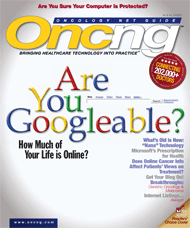Publication
Article
ONCNG Oncology
"Nana" Technology: Anatomy of Tomorrow
George Mason University Assistant Professor Andrew Carle (http://chhs.gmu.edu/directory/carle.html) coined the term "nana" technology last year as an all-encompassing name for the multibillion...
George Mason University Assistant Professor Andrew Carle coined the term “nana” technology last year as an all-encompassing name for the multibillion-dollar industry that serves the quickly growing elderly population with innovative devices and services. We include several examples here:
These pill dispensers use audio and visual cues, such as fl ashing lights, spoken words, and songs, to remind elderly patients when it’s time to take their medications. If the medications aren’t taken within a specifi ed time, some dispensers will call selected caregivers to alert them, and others will send a message to a secure Internet site, prompting a healthcare professional to check up on the patient.
Able to send a distress signal even if the patient is unconscious, these monitors—worn around the neck—recognize when the user has fallen, sending a wireless phone signal to a central offi ce that can dispatch help.
Elderly patients no longer need to get up and down or pull out their magnifying glass to adjust the temperature in their home, thanks to this innovation. After programming the device—some models of which feature talking buttons—users can put away the afghan and blanket and turn the temperature up using voice commands, after initiating them via large tactile buttons or clapping their hands.
These devices send wireless signals from the mailbox to a small receiver in the home or apartment—even those as high as seven
stories up—allowing seniors to avoid repeat trips to check if their mail has arrived, trips that can be especially risky during inclement weather or if the patient uses a walker or cane.
Online Medicine Cabinet
The mirrors used in these medicine cabinets are equipped with a camera and online computers with face-recognition software. The device will greet users by name, identifying different household members. The medicine cabinets will also warn when users are not adhering to their medication plans and enable patients to monitor vital signs and make doctor appointments. Search for “online medicine cabinet.”
Balance Boosters
Older adults at risk of falling may benefit from these soon-to-be-marketed shoes that feature insoles that send small vibrations to the bottom of the foot, “tickling” neurons and making them more sensitive to signals that would be detected in people with normal balance.
Walking Aid
Futuristic walking aids may include walkers that steer away from obstacles and can be returned to the user by remote control when put away, as well as canes that sound alarms when the user is in danger of falling, by taking advantage of sensors that detect pressure and gait. These devices can also beep to help the user remember where they’ve been placed.
